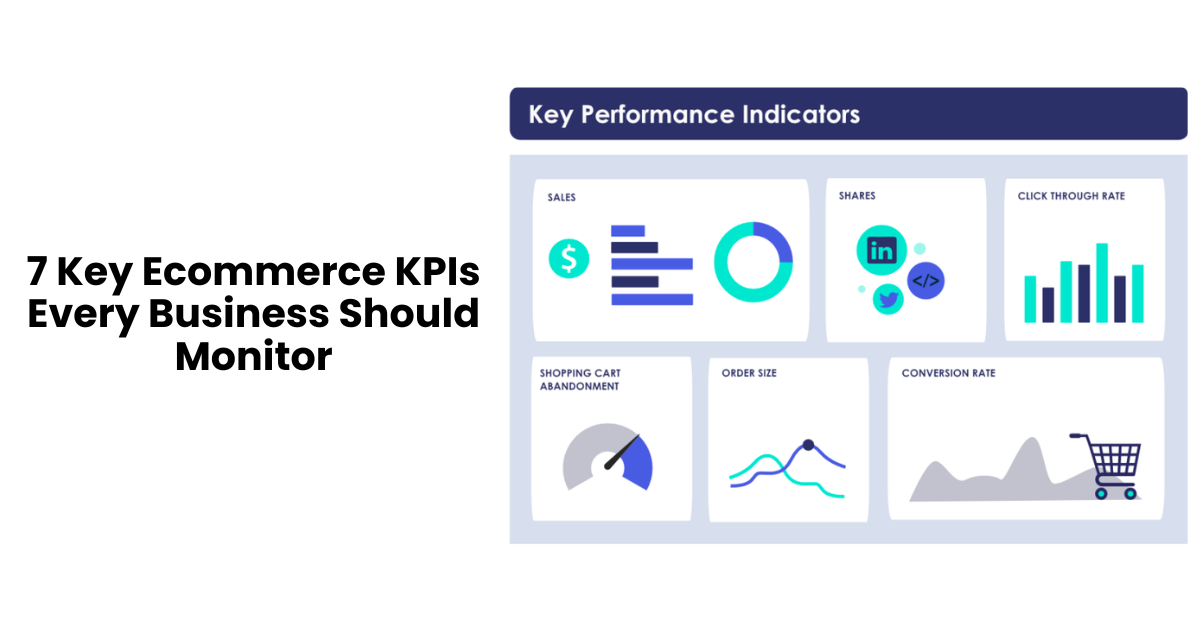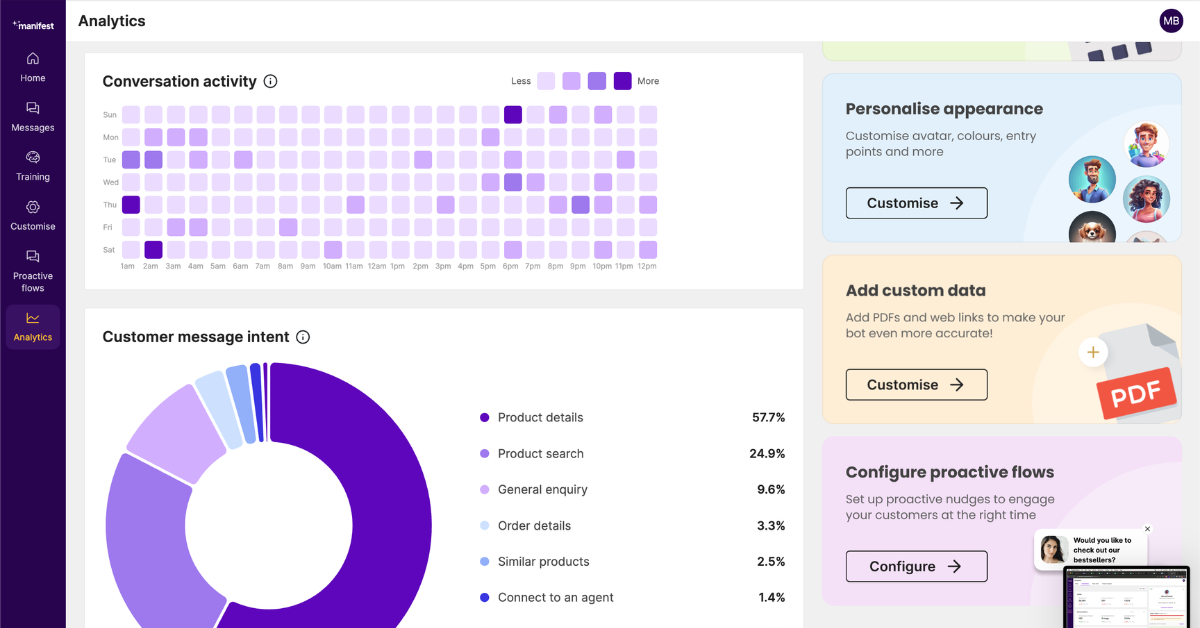7 Key Ecommerce KPIs Every Business Should Monitor

In the dynamic world of e-commerce, tracking the right Key Performance Indicators (KPIs) is essential for any business aiming for success. These KPIs serve as vital checkpoints, helping businesses to measure performance, understand customer behavior, and make data-driven decisions. For e-commerce entities, where competition is fierce and customer preferences constantly evolve, knowing which metrics to monitor can be the key to sustained growth and profitability. This exploration into the seven key ecommerce KPIs is designed to guide businesses in identifying and focusing on the most critical metrics, ensuring they effectively track progress and adapt strategies for continued success.
What are Ecommerce KPIs?

Ecommerce KPIs (Key Performance Indicators) are metrics used by online businesses to measure and track their performance, success, and growth. These indicators provide insights into various aspects of an e-commerce operation, such as sales performance, customer engagement, marketing effectiveness, and website functionality. Common ecommerce KPIs include sales conversion rates, average order value, website traffic, customer acquisition cost, cart abandonment rate, and customer lifetime value. By analyzing these ecommerce KPIs and metrics, e-commerce businesses can identify areas of success and opportunities for improvement, make informed decisions, and strategize effectively to enhance overall business performance. Essentially, KPIs act as a compass, guiding e-commerce businesses towards their goals in a competitive online marketplace.
Here are the 7 top ecommerce KPIs every business need:
Bounce Rate

Bounce Rate is a crucial KPI for e-commerce brands, indicating the percentage of visitors who leave the website after viewing only one page. A high bounce rate can signal that your website isn't engaging enough or fails to meet visitor expectations. This metric is vital for understanding user behavior and the effectiveness of your site in retaining visitors.
Strategies to Improve Bounce Rate:
- Enhance Website Design: Ensure your website is visually appealing, user-friendly, and easy to navigate.
- Improve Page Load Speed: Fast-loading pages reduce the likelihood of visitors leaving out of frustration.
- Optimize Content: Provide clear, relevant, and engaging content that matches what your visitors are looking for.
- Effective Call-to-Action: Include clear CTAs to guide visitors to the next step, whether it's making a purchase or reading more content.
- Mobile Optimization: Ensure your site is responsive and mobile-friendly, as a significant portion of traffic comes from mobile devices.
- Utilize Targeted Keywords: Use SEO strategies to attract the right audience to your site.
Click-Through Rate (CTR)

Click-Through Rate (CTR) is a crucial metric for e-commerce brands, offering insights into the effectiveness of online advertising and marketing campaigns. It measures the ratio of users who click on a specific link to the number of total users who view a page, email, or advertisement. Essentially, CTR is a key indicator of how well your content is resonating with your target audience and compelling them to take action.
Website traffic
Website traffic, a crucial ecommerce KPI for e-commerce brands, measures the number of visitors to an online store. It's a fundamental metric as it represents the initial step in the customer journey, leading to potential sales and conversions. High website traffic often indicates effective marketing efforts and brand visibility.
To improve website traffic, consider these strategies:
- SEO Optimization: Enhance your website's SEO to improve search engine rankings, making it easier for potential customers to find you online.
- Content Marketing: Create engaging, relevant content to attract visitors. Blogs, videos, and infographics can drive traffic and improve SEO.
- Social Media Marketing: Utilize social media platforms to promote products and content, driving traffic to your website.
- Paid Advertising: Invest in pay-per-click (PPC) campaigns and social media ads to target specific audiences and bring in traffic.
- Email Marketing: Send newsletters and promotions to your email list to encourage visits to your site.
Conversion Rate
Conversion Rate is a one of the most important KPIs for e-commerce brands, indicating the percentage of visitors who complete a desired action on a website, such as making a purchase. It's a direct measure of an e-commerce site's effectiveness in converting visits into sales.
A low conversion rate may suggest issues with the website's design, user experience, product appeal, pricing, or marketing strategies. Conversely, a high conversion rate indicates effective engagement and persuasion of visitors to make purchases.
Strategies to Improve Conversion Rate:
- Optimize Website Design: Ensure your website is user-friendly, with intuitive navigation and a clean, appealing layout.
- Enhance User Experience: Reduce loading times and ensure your website is mobile-responsive, as a significant portion of e-commerce traffic comes from mobile devices.
- Improve Product Descriptions: Provide detailed, accurate product descriptions along with high-quality images and videos.
- Simplify the Checkout Process: Streamline the checkout process to reduce cart abandonment. This includes fewer steps to purchase, multiple payment options, and clear shipping information.
- Utilize Customer Reviews: Display customer reviews and ratings to build trust and provide social proof.
Bounce Rate
Bounce Rate is one of the critical ecommerce KPIs in e-commerce that measures the percentage of visitors who land on your website and leave without browsing other pages. It's an indicator of engagement and relevance; a high bounce rate often suggests that your site's landing pages are not resonating with your audience or meeting their expectations.
Strategies to Improve Bounce Rate:
- Enhance Website Design: Ensure your website is visually appealing, user-friendly, and easy to navigate.
- Optimize Page Load Speed: Slow-loading pages are a common cause of high bounce rates.
- Relevant and Engaging Content: Provide clear, concise, and engaging content that matches what your audience is searching for.
- Effective Call-to-Action (CTA): Include compelling CTAs that encourage visitors to explore more.
- Improve User Experience (UX): Streamline the user journey to make it intuitive and hassle-free.
- Mobile Optimization: As a significant number of users shop on mobile devices, ensure your website is mobile-friendly.
- Use Targeted Keywords: Incorporate keywords that accurately reflect the content of your pages.
Unsubscribe Rate
The Unsubscribe Rate in e-commerce is one of the most important ecommerce marketing KPIs that measures the percentage of subscribers who opt out of your email marketing list. It's a direct indicator of how relevant and engaging your email content is to your audience. A high unsubscribe rate can signal that your emails are not resonating with your customers or are too frequent.
To improve this KPI, consider the following strategies:
- Segment Your Audience: Customize your emails based on customer behavior and preferences. More relevant content can lead to lower unsubscribe rates.
- Optimize Email Frequency: Find a balance in how often you send emails. Too many can overwhelm subscribers, leading them to unsubscribe.
- Quality Over Quantity: Focus on creating high-quality, engaging content that adds value to your subscribers.
- Easy Opt-Out Process: Ensure that the process of unsubscribing is straightforward. A complicated process can frustrate customers and damage your brand's reputation.
- Welcome Feedback: Include a brief survey or feedback form for those who unsubscribe to understand their reasons and improve future communications.
List Growth Rate
The List Growth Rate is of the most vital ecommerce KPIs that measures the rate at which an email subscriber list is growing. It's crucial for e-commerce brands as a growing list indicates a wider audience reach and potential for increased sales. This metric is calculated by taking the number of new subscribers, subtracting the number of unsubscribes, and then dividing by the total number of existing subscribers.
To improve the List Growth Rate, consider the following strategies:
- Optimize Website Sign-Up Forms: Ensure that email sign-up forms are prominently placed across your website, especially on high-traffic pages.
- Incentivize Subscriptions: Offer discounts or exclusive content as an incentive for signing up to your mailing list.
- Leverage Social Media: Use your social media platforms to encourage followers to subscribe to your email list.
- Content Marketing: Create valuable content that prompts readers to subscribe for more information or updates.
- Referral Programs: Implement referral programs that reward existing subscribers for bringing in new ones.
Email ROI
Email ROI, or Return on Investment for email marketing, is a crucial KPI for e-commerce brands. It measures the effectiveness of email marketing campaigns in generating revenue relative to the cost of running them. This KPI is vital as it helps e-commerce businesses understand the financial impact of their email marketing strategies.
To calculate Email ROI, subtract the cost of the email campaign from the revenue generated by it, then divide by the campaign cost and multiply by 100. This gives you the ROI as a percentage.
Improving Email ROI involves several strategies:
- Segment Your Audience: Tailor your emails to different customer segments based on their preferences and behaviors. This personalization can lead to higher engagement and conversion rates.
- Optimize Email Content: Test different subject lines, email layouts, and content to see what resonates best with your audience.
- Automate Email Campaigns: Use automated email campaigns for welcome emails, abandoned cart reminders, and other customer touchpoints.
- Monitor and Test: Continuously track the ecommerce performance KPIs of your emails and experiment with different approaches to improve engagement and conversions.
- Leverage Data Analytics: Use data analytics to gain insights into customer behavior and preferences, allowing for more targeted and effective email campaigns.
How to improve ecommerce kpis using Manifest AI?

Improving ecommerce KPIs using Manifest AI can be achieved through:
- Personalized Customer Engagement: Utilize Manifest AI to analyze customer data and tailor marketing strategies, enhancing customer experience and conversion rates.
- Efficient Lead Qualification: Leverage AI to identify and focus on high-value leads, improving sales efficiency and ROI.
- Data-Driven Insights: Use Manifest AI’s analytical capabilities for actionable insights, helping to refine marketing and sales strategies for better performance.
Conclusion
In summary, monitoring the right e-commerce KPIs is essential for any online business looking to thrive in today's digital marketplace. These seven key KPIs provide a comprehensive view of various aspects of your e-commerce operation, from sales and marketing to customer engagement and website performance. By keeping a close eye on these metrics, businesses can make informed decisions, adapt strategies effectively, and identify areas for improvement. Regularly tracking these KPIs ensures that e-commerce brands stay aligned with their goals and are well-equipped to respond to changing market dynamics and consumer behaviors.

.png)
